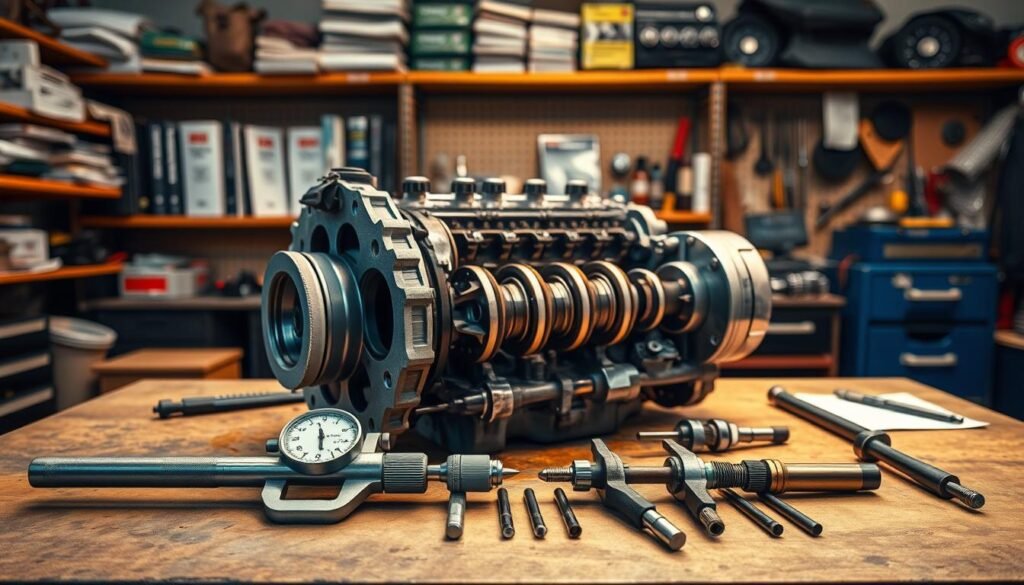Replacing rod bearings in a 3.2L VR6 engine is a critical step in 3.2L VR6 engine repair. This process involves removing the oil pan, disassembling connecting rods, and installing new bearings to ensure engine longevity. Proper execution requires precision, quality parts like HPA’s Race Grade Bearings, and strict adherence to torque specs.
Professional precision prevents costly engine damage. HPA’s bearings, rated up to 650 horsepower, reduce wear and improve fatigue strength. Engine overhaul demands attention to lubrication and alignment to maintain reliability. This guide breaks down steps for safe, effective replacement.
Key Takeaways
- Correct rod bearings replacement ensures engine reliability and performance.
- HPA’s Race Grade Bearings support high-horsepower applications up to 650 hp.
- Engine overhaul requires precise torque and proper lubrication methods.
- Quality bearings like HPA’s extend engine lifespan by reducing friction and wear.
- Choosing aftermarket parts over OEM options may be necessary for high-performance use.
Introduction to the 3.2L VR6 Engine
The 3.2L VR6 engine combines advanced VR6 engine design with precision engineering to deliver powerful performance in compact spaces. This inline-V configuration positions its cylinders at a 15-degree angle, merging the efficiency of an inline-four with the power of a V6. Its engine internals work together to convert fuel energy into motion, making it a favorite in performance vehicles like the Volkswagen Passat and Audi models.
Overview of VR6 Engine Design
This engine’s layout reduces weight and improves balance compared to traditional V6 setups. Key features include:
- Compact 15° cylinder angle for smaller engine bay fitment
- Inline crankshaft design for smoother power delivery
- Lightweight alloy construction for reduced rotational mass
| Component | Purpose |
|---|---|
| Cylinder banks | Optimize airflow and combustion efficiency |
| Crankshaft | Transfers piston motion to rotational energy |
| Rod bearings | Facilitate smooth crankshaft-piston rod movement |
Importance of Rod Bearings Function
Rod bearings act as critical rod bearings function components within the engine’s rotating assembly. These metal sleeves allow the connecting rods to pivot freely on the crankshaft while managing heat and pressure. Without properly functioning rod bearings, excessive friction can lead to costly engine damage. Proper maintenance of these engine internals ensures consistent power transfer and longevity of the VR6’s performance.
Essential Tools and Safety Tips
Replacing rod bearings demands the right engine repair tools and strict adherence to safety tips. Start by gathering specialized equipment like a dial bore gauge for precise clearance checks, an engine brush set to clean oil passages, and a crank socket for crankshaft rotation. A piston ring squaring tool ensures proper ring alignment, critical for engine function.
- Dial bore gauge: Measures bearing clearances to ensure proper fit.
- Engine brush set: Removes sludge from oil passages and tight spaces.
- Crank socket: Rotates the crankshaft smoothly during assembly.
- Piston ring squaring tool: Aligns piston rings for optimal sealing.
Workshop safety starts with securing the engine on a sturdy stand to prevent movement. Clean components thoroughly: scrub oil passages with a wire brush, then wash in hot soapy water. Dry parts with compressed air, but never spin bearings with compressed air—this can cause violent disintegration. Always hold bearings against a lint-free cloth while drying. Lubricate bearings and fasteners with assembly lube to avoid torque errors and friction during startup.
“Grease only bearings you’re installing immediately. Delayed installation risks contamination from grinder dust.”
Follow workshop safety protocols: wear eye protection, use gloves, and ventilate your workspace. Clean all fasteners and check for damage before reuse. Proper safety tips and tools turn a complex job into a manageable task. Taking time here prevents costly mistakes later.
Diagnosing Rod Bearing Issues in Your 3.2L VR6
Early rod bearing diagnostics can save your VR6 engine from costly repairs. Listen for telltale sounds like a metallic tapping during acceleration—this often signals engine wear detection needs. Unusual oil consumption or overheating are also red flags. Catching these signs early prevents catastrophic damage.

Signs of Bearing Wear
- Knocking noise: A rhythmic “clunk” when accelerating indicates bearings are loose or worn.
- Oil leaks: Check for seepage around the crankcase—this points to compromised seals or bearing misalignment.
- Performance loss: Sudden power drops or rough idling may signal VR6 fault diagnosis is needed.
Diagnostic Techniques for Bearing Issues
Start with a visual inspection. Use a micrometer to measure bearing clearance—specifications vary, but most VR6 engines require 0.001-0.003 inches of clearance. Excessive play means replacement. For advanced rod bearing diagnostics, remove the oil pan to inspect bearing surfaces for scoring or discoloration. Always consult your service manual for torque specs and alignment checks.
Preparing Your Workspace for Replacement
Proper workspace preparation sets the stage for a successful rod bearing replacement. Start by clearing your engine workshop setup of clutter. Use a clean, well-lit area with a flat surface large enough to hold all tools and parts. Lay down drop cloths to protect surfaces from oil and metal shavings.
- Clean the engine block thoroughly. Use brushes to scrub oil passages and compressed air to blow out debris.
- Organize tools and parts using labeled containers. This pre-repair organization keeps bearings and caps sorted during disassembly.
- Mark each connecting rod and cap with corresponding numbers using paint pens or stickers. This prevents misalignment during reassembly.
- Test-fit bearings in their bores before removing old components. This ensures proper fit without contamination.
Store small parts like shims and bolts in clear trays. A magnetic tray keeps screws accessible and prevents loss. Keep a checklist nearby to track each step—this reduces errors and saves time. Proper setup avoids costly mistakes like mixing rod caps or improper torque sequences later.
Step-by-Step Guide: how to replace rod bearings in 3.2l vr6
Replacing rod bearings requires precision to maintain engine integrity. Follow these core steps for a successful step-by-step rod bearing replacement:
Removing the Old Rod Bearings
- Use a pry bar to carefully separate the connecting rod cap from the bearing. Avoid twisting to prevent warping.
- Clean the rod and cap surfaces with solvent to remove oil and debris. Engine bearing removal must expose all mating surfaces for inspection.
- Check the rod journals for scoring. Record any damage for alignment verification.
Installing New Rod Bearings
- Lubricate new bearings with engine oil before pressing them into place. Proper lubrication ensures smooth insertion.
- Align the bearing halves and secure the rod cap with factory-specified torque specs. Tighten in stages to avoid misalignment.
Checking Clearance and Tolerances
Accurate measurements prevent premature wear. Use a micrometer to verify:
| Parameter | Optimal Range |
|---|---|
| Bearing clearance | 0.0015–0.0025 in |
| Rod roundness | ≤0.0002 in |
| Taper | ≤0.0003 in over 1 in |
Ensure bearings meet specs for clearance check accuracy. Reinstall only when all measurements align.
Reinstalling the Connecting Rods and Finishing Up

Once bearings are in place, the focus shifts to precise engine reassembly. Proper reinstall connecting rods ensures the engine runs smoothly. Follow these steps to avoid costly mistakes:
Reattaching the Connecting Rods
- Verify rod and cap numbering matches OEM markings to prevent misalignment.
- Clean all surfaces with a lint-free cloth to remove debris before assembly.
- Use OEM-recommended lubricant on bearing surfaces during installation.
Torque Specifications and Safety Checks
Misaligned bolts or incorrect torque can cause catastrophic failure. Follow these guidelines:
| Bolt Type | Method | Initial Torque | Angle (After Torque) |
|---|---|---|---|
| 3/8 x 1.500” bolts | Stretch/Torque & Angle | 25 ft-lbs | +55° |
Always start tightening from the center rod cap outward to distribute pressure evenly. Molnar Technologies recommends using a torque wrench with a torque-angle method for critical bolts.
“Improperly torqued bolts are the #1 cause of rod failures in high-performance engines.” – Molnar Technologies Technical Manual
After tightening, rotate the crankshaft manually to ensure smooth movement. Measure crankshaft end play between 0.002″ and 0.008″ using a dial indicator. Any binding requires disassembly and inspection.
Final checks include:
– Lubrication on all moving parts
– Cleanliness of oil galleries
– Proper timing chain alignment
Remember, precise engine reassembly demands patience. Rushing this phase risks costly repairs. Double-check torque specifications for each fastener before final startup.
Troubleshooting Common Issues During Replacement
Post-repair checks are critical to ensure the 3.2L VR6 runs smoothly. Engine troubleshooting often reveals issues like knocking sounds or oil pressure drops, signaling unresolved rod bearing issues. Address these early to prevent costly damage.
Common Post-Repair Issues
Key problems after installation include:
- Improper bearing clearance causing overheating
- Crankshaft misalignment leading to vibration
- Oil leaks from loose seals
| Issue | Solution |
|---|---|
| Knocking noise during acceleration | Recheck bearing clearances and alignment |
| Low oil pressure | Verify oil pump function and filter integrity |
| Excessive oil consumption | Inspect piston rings and valve stem seals |
“Persistent metallic scraping sounds after reassembly demand immediate professional evaluation.”
When to Seek Professional Help
Consult a specialist if you encounter:
- Unstable engine idle or severe vibrations
- Visible metal shavings in oil after startup
- Recurring overheating despite proper lubrication
Professional repair advice becomes critical if crankshaft journals show scoring or bearings exhibit uneven wear. DIYers unsure of clearance measurements should prioritize certified technicians. Repair costs vary: minor adjustments cost $300–$600, while full bearing replacements may reach $2,000–$7,000 depending on labor and parts.
Maintenance Tips for Long-Lasting 3.2L VR6 Performance
Protect your investment with these engine maintenance tips tailored for your VR6. Start by scheduling regular oil changes every 3,000-5,000 miles to remove contaminants that cause wear. Monitor oil levels weekly—low oil accelerates bearing damage and compromises long-term engine health.
Keep a maintenance log! Record torque specs and clearance measurements from your repair. This data helps spot trends over time. Use it to compare future inspections and catch issues early—a key part of VR6 performance care.
- Clean components like crankshaft journals and bearing surfaces every 12,000 miles to prevent sludge buildup
- Upgrade to high-quality bearings like ACL’s Race Series for RPM-heavy driving. Their tri-metal design and hardened steel backs resist distortion at high speeds
- Inspect connecting rod bolts every 50,000 miles—loose bolts can destabilize bearings
A proactive approach pays off. Pairing premium parts like ACL bearings with consistent checks ensures your engine runs strong for years. Small steps now save costly repairs later. Stay ahead of wear and tear—it’s the secret to keeping that iconic VR6 growl alive!
Conclusion
An engine repair summary for the 3.2L VR6 highlights the precision needed during rod bearings conclusion steps. Proper diagnosis, component alignment, and torque settings like 30 Nm plus a 90-degree turn for connecting rod bolts are vital. Skipping these steps risks issues like oil starvation, which can cause a “Number 2 Spun Bearing” and require costly rebuilds. A VR6 engine wrap-up must stress adherence to manufacturer guidelines to avoid severe damage.
Regular maintenance extends engine life, especially for high-performance engines like the VR6. Small issues like unusual knocks or reduced power should prompt immediate checks. Cleanliness during disassembly and precise reassembly protect against wear and tear. Remember: even minor oversights can lead to major repairs, so follow safety protocols closely.
Confidence in completing this task comes from careful planning and attention to detail. By referencing this guide, you’ve already taken a key step toward successful repairs. Keep this resource handy for future reference and prioritize routine inspections to keep your VR6 running smoothly for years. Safe work practices and regular checks ensure your engine stays reliable and powerful.



